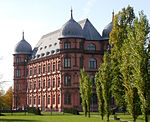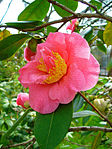Hauptfriedhof Karlsruhe
1580s architectureCemeteries in EuropeLutheran cemeteries

The Hauptfriedhof in Karlsruhe is one of the oldest German communal rural cemeteries. In 1871, the first plans to build a new burial ground outside the city center began. The cemetery was laid out in 1874 by Josef Durm in the Rintheim district, east of the actual city, after the inner-city Alter Friedhof Karlsruhe in the Oststadt had become too small. The main cemetery has grown from its original size of 15.3 hectares in 1873 to over 34 hectares. The graves of more than 32,000 deceased are currently in the cemetery.
Excerpt from the Wikipedia article Hauptfriedhof Karlsruhe (License: CC BY-SA 3.0, Authors, Images).Hauptfriedhof Karlsruhe
Hirtenweg, Karlsruhe Rintheim
Geographical coordinates (GPS) Address Nearby Places Show on map
Geographical coordinates (GPS)
| Latitude | Longitude |
|---|---|
| N 49.017462 ° | E 8.435429 ° |
Address
Bürklin'sches Mausoleum
Hirtenweg
76131 Karlsruhe, Rintheim
Baden-Württemberg, Germany
Open on Google Maps







